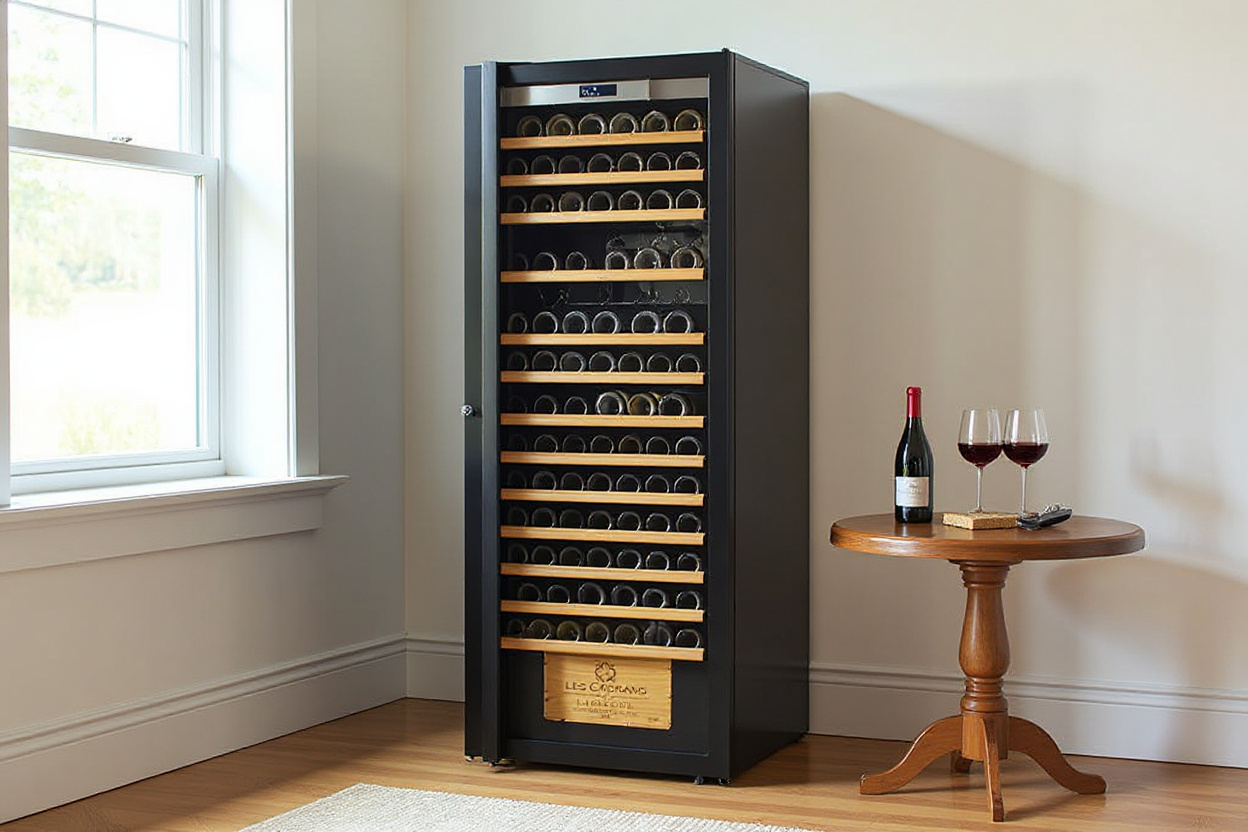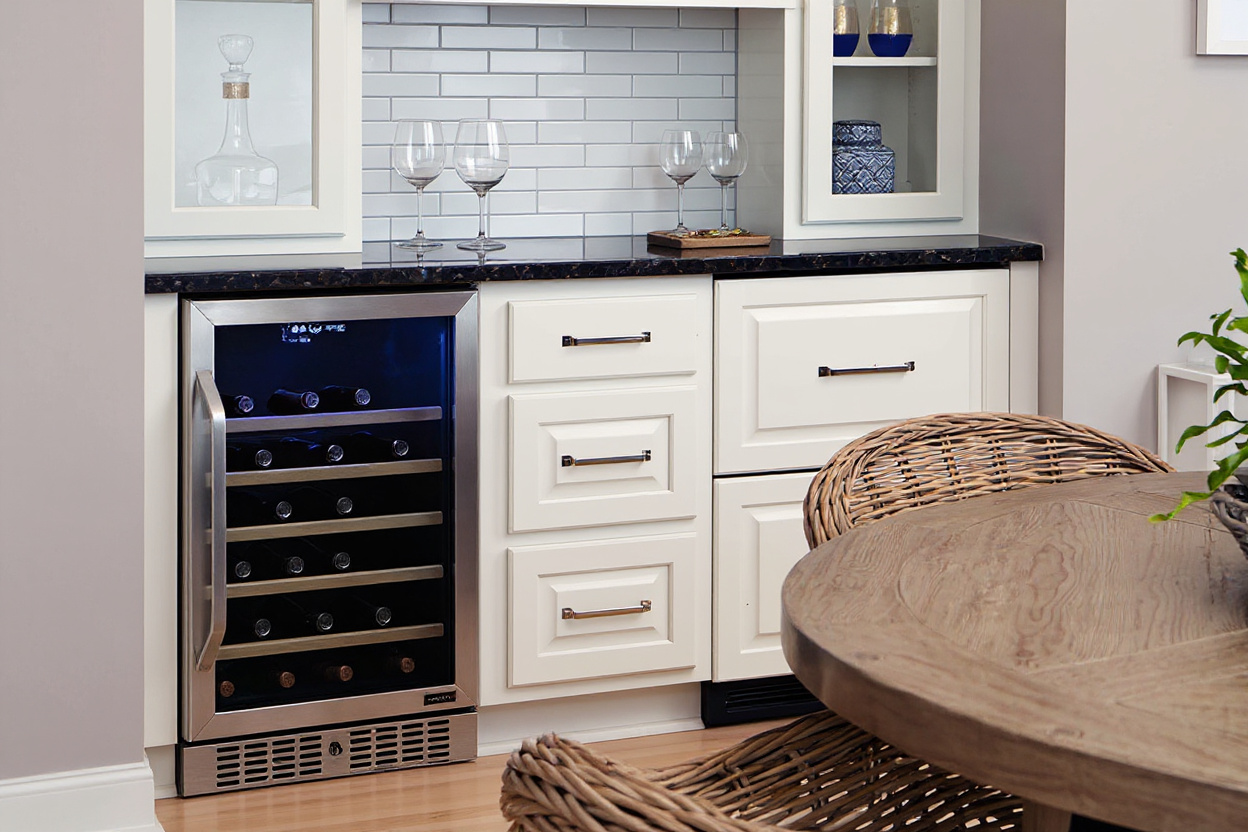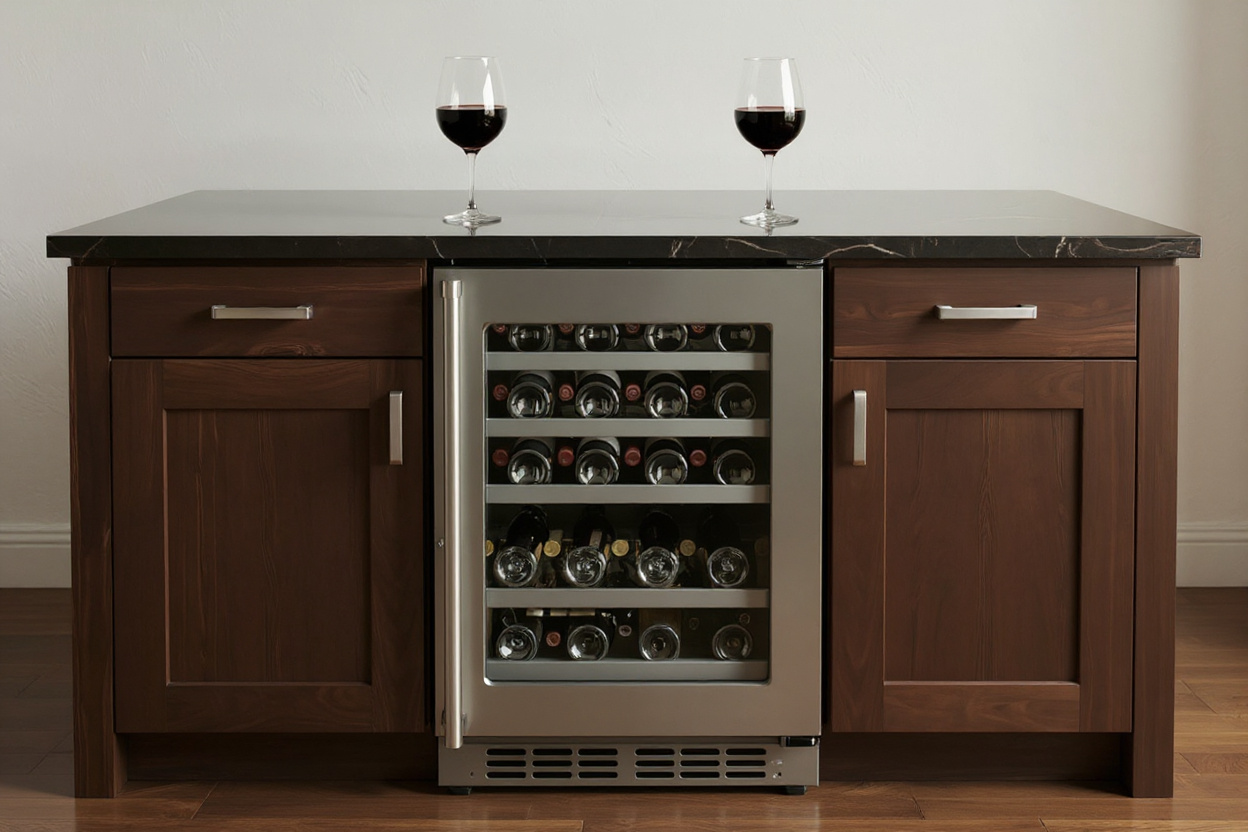Choosing the perfect wine cooler refrigerator can transform how you store, preserve, and enjoy your wine collection—whether at home or in a professional setting. This comprehensive guide explores everything you need to know about freestanding models, including ideal capacity, temperature zones, and advanced features that protect your wine while complementing your kitchen or entertainment space.
Freestanding wine cooler buying guide
Freestanding wine coolers offer unmatched versatility for enthusiasts who value both aesthetics and performance. Unlike built-in options, these appliances provide easy mobility while delivering precise temperature control tailored to your collection. Understanding key specifications—from capacity to vibration reduction—helps you select a wine fridge that serves your needs for decades.
What capacity fits your space
Matching your wine cooler’s capacity to your collection requires evaluating both current and future needs. Small units (6–12 bottles) suit occasional drinkers, while mid-sized options (20–100 bottles) accommodate growing collections. For serious collectors or commercial use, large-capacity models (166+ bottles) offer ample storage. Remember: manufacturer ratings assume standard 750ml Bordeaux bottles—Champagne or magnum formats reduce actual capacity by 20–30%.
Smart buyers choose a wine cooler refrigerator with 10–20% extra space beyond their current collection. This foresight allows room for new additions without needing an upgrade. Always verify internal dimensions if you frequently store unusually shaped bottles.
Temperature, noise and vibration essentials
A high-quality freestanding wine cooler maintains cellar-like conditions with precise temperature control (5–20°C ±1°C variation). Compressor-based units with R600a refrigerant outperform basic thermoelectric models, especially in warmer environments. For quiet operation in living spaces, prioritize models under 45dB—preferably 25–39dB for open-concept kitchens. Advanced anti-vibration systems protect delicate older wines by minimizing disruptive movements.
Placement rules for freestanding units
Proper installation dramatically impacts your wine fridge’s performance and lifespan. Allow 5–8cm clearance on sides/back and 25–30cm above the appliance for ventilation. Avoid enclosing it in cabinetry (unless designed for built-in use) to prevent overheating. Keep the unit away from heat sources like ovens or direct sunlight—these force the compressor to work harder.
For garages or unheated spaces, select models with winter modes or internal heaters. Adjustable feet stabilize the appliance on uneven floors, while ensuring adequate door clearance allows full access to shelves. Always check the climate class rating matches your room’s ambient temperature.
Dual Zone Wine Cooler Versus Single Zone
The temperature zones in your wine storage setup significantly impact how well it accommodates different wine varieties and drinking occasions.
While a single-zone wine cooler refrigerator maintains one stable temperature ideal for aging a single wine type, a dual zone wine cooler provides the flexibility to store and serve multiple wines at their optimal temperatures simultaneously.
Who Needs a Dual Zone Wine Cooler
Serious wine collectors benefit immensely from dual zone capabilities, as they can properly store both temperature-sensitive whites and robust reds in the same unit.
A well-designed wine cooler with independent temperature zones lets you keep crisp whites at 8°C in the upper compartment while aging bold reds at 16°C below – perfect for those who appreciate variety.
This dual zone functionality proves particularly valuable in professional settings during busy service hours.
Restaurants and wine bars can serve chilled sparkling bottles alongside slightly warmer reds without any temperature adjustment delays, ensuring every pour meets exact serving standards.
Home entertainers enjoy similar advantages when hosting gatherings, as they can offer properly chilled whites and properly tempered reds simultaneously.
Discover this 6-bottle dual-zone wine cooler refrigerator , featuring precise control from 3-18°C thanks to advanced cooling technology. It accommodates standard bottles to large magnums while offering UV protection and user-friendly LED controls.
Serve-Ready Temperatures Made Easy
A dual zone wine cooler takes the guesswork out of serving temperatures, maintaining each wine at its ideal drinking condition.
The science of serving temperatures is simple: sparkling wines at 5-8°C, light whites/rosés at 8-12°C, lighter reds at 13-16°C, and full-bodied reds at 16-18°C.
Most practical setups use the upper zone for service-ready whites (6-8°C) and the lower section for reds (12-16°C), creating an efficient serving system that eliminates waiting time when entertaining guests.
Shelving and Bottle Compatibility
Modern wine storage solutions address diverse bottle collections through adaptable shelving designs.
Adjustable wooden racks comfortably hold everything from Champagne bottles to Burgundy shapes and magnums, though this flexibility may slightly reduce total capacity .
Quality manufacturers provide honest capacity estimates that account for mixed bottle sizes, helping buyers make informed decisions about their wine storage needs.
Telescopic shelving maintains convenient access while keeping bottles properly horizontal – crucial for preserving cork integrity and wine quality.
Stainless steel style and performance
For modern wine storage needs, stainless steel wine coolers offer the perfect balance of sleek style and practical functionality . These stylish wine fridge units enhance contemporary kitchen designs while providing crucial wine preservation features like UV-resistant glass doors, precise temperature control across multiple zones, and whisper-quiet operation ideal for open living spaces.
Choosing a stainless display wine fridge
When selecting the best wine cooler refrigerator, it’s important to look beyond just the surface appeal. While a stainless steel wine cabinet should be visually appealing, focus on the technical specifications that truly impact wine storage quality and longevity.
- Temperature stability : The top wine cooler refrigerator models maintain temperatures within a ±1°C range and recover quickly after the glass door is opened – essential for both frequent entertaining and professional settings.
- UV protection : Seek units with double or triple-paned glass doors featuring UV-blocking technology to protect your wine while keeping it visible and accessible.
- Humidity management : Reliable wine storage requires maintaining 50-70% humidity to keep corks moist and labels intact.
Check out our 8-Bottle Dual-Zone Countertop Wine Cooler offering compressor cooling (3-18°C) in a space-saving 78 × 33 × 29 cm package. It accommodates standard and magnum bottles while featuring adjustable LED lighting and double-wall glass – perfect for both homes and businesses.
Energy, noise and durability checks
A truly high-quality wine fridge balances performance with efficiency and durability. Keep these key factors in mind when evaluating your options:
Modern wine cooler refrigerator models using R600a refrigerant typically consume just 70-150 kWh annually while meeting strict environmental standards. This makes them significantly more efficient than older cooling systems.
For open kitchen layouts, opt for ultra-quiet units operating at 25-39 dB. Examine build quality by testing door seals, hinges, insulation quality, and shelf sturdiness to ensure years of reliable service from your wine cabinet.
From chilling to preserving and pouring
The best wine storage solutions today go beyond basic cooling, offering advanced preservation and serving conveniences that mimic professional setups.
Smartly designed wine fridge units now include dedicated pass-throughs for accessory integration, allowing you to connect preservation systems while maintaining a fully sealed glass door environment.
Consider our compact 2-bottle wine cooler (Wibox 2) which provides precise temperature control (5-18°C) in a modest 29 × 26 × 26 cm footprint. It accommodates larger bottle sizes, features convenient LED lighting, and operates with exceptional energy efficiency – ideal for tasting sessions and quick access.
Undercounter Dual and Freestanding Choices
Deciding between an undercounter installation versus a freestanding model significantly impacts both setup requirements and ongoing operation. Understanding these core differences helps prevent costly mistakes while ensuring your wine storage solution matches your available space and design preferences perfectly.
Can a Wine Cooler Replace a Fridge?
While premium wine cooler refrigerator units can reach serving temperatures (5–8 °C for sparkling wines), they’re not suitable replacements for standard refrigerators. These specialized appliances precisely regulate temperature ranges, humidity control , and minimize vibrations specifically for wine preservation – not food safety.
Regular refrigerators maintain 0–4 °C to preserve perishables, while wine storage units typically keep 10–15 °C for aging and 5–18 °C for serving. Humidity levels also differ: wine coolers maintain 50–70% humidity to keep corks moist, whereas food fridges operate much drier.
That said, a wine fridge makes an excellent secondary beverage chiller for entertaining. With precise temperature control and reduced vibrations, it’s ideal for champagne, beer, and similar drinks requiring gentle handling – just don’t use it for dairy, meats, or anything needing sub-5 °C storage.
Built-in Versus Freestanding Basics
Built-in wine coolers feature front or bottom ventilation for seamless cabinet integration, while freestanding models require open space on all sides for heat dissipation. Installing a rear-vented freestanding unit within cabinetry risks overheating and voids warranties.
Undercounter dual zone units (sometimes called undercounter dual models) integrate beautifully into kitchen spaces while offering two temperature zones for different wines. They typically cost more than comparable freestanding versions but provide better energy efficiency and a streamlined appearance when properly installed.
| Feature | Freestanding | Built-in |
| Ventilation | Sides/rear/top clearance required | Front/base venting for flush fit |
| Mobility | Easily relocated | Permanent installation |
| Cost | Generally lower initial price | Higher cost, installation complexity |
| Capacity range | 6-312+ bottles available | Limited by cabinet dimensions |
Thanks to their flexible installation, freestanding units work well for renters, frequent movers, or spaces without custom cabinetry. Slim-depth models (around 58 cm) fit compact kitchens while maintaining full vertical capacity , though you’ll still need to consider door swing and shelf access space.
Retail Comparison Tips for Buyers
Effective in- store comparisons should evaluate real-world performance, not just technical specifications. Request temperature logs showing 48-hour stability on each shelf, and test actual bottle capacity by loading different shapes rather than relying on standard Bordeaux counts.
Warranty coverage varies dramatically: premium brands often include three to five years of compressor protection with expected lifespans exceeding two decades. Basic models typically offer just one to two years of coverage – sufficient for short-term use but providing less long-term security.
Delivery considerations become particularly important for undercounter dual zone wine installations requiring precise measurements and proper electrical connections. Before purchasing, confirm inventory, verify stairwell access, and check if the retailer offers old appliance removal. Many dealers also provide financing options or trade-in programs that make high-end models with advanced control features more accessible.
Wine cooler countertop solutions
Countertop wine chillers offer the perfect blend of convenience , performance, and space-saving design. These compact wine coolers deliver professional temperature control , keeping your bottles at their ideal serving conditions while fitting perfectly on kitchen counters, bar tops, or tasting room surfaces where easy access and visual appeal matter most.
Compact cooling for immediate service
These efficient small wine coolers typically hold 2-8 bottles while maintaining precise temperature zones for different varietals. Perfect for wine bars and restaurants, they ensure every bottle is always ready to serve at the perfect chill.
- Space-saving design : From compact 2-bottle units (29×26×26 cm) to larger 8-bottle models (78×33×29 cm), these fit seamlessly in any kitchen without modifications.
- Easy access : Vertical bottle storage and a glass door make selection quick during busy service hours.
- Temperature precision : Advanced compressors maintain ±1°C accuracy, even in warm kitchen environments up to 30°C.
- Display potential : Built-in LED lighting transforms your wine cooler into an attractive showcase that boosts sales.
This combination of functionality and visual appeal makes countertop units ideal for commercial spaces where you want to entice customers while ensuring perfect serving conditions.
Integration with preservation systems
Today’s small wine fridges can connect with preservation systems for extended bottle life. Specialized designs allow the glass door to close properly even when connected to inert gas systems.
This integration can keep opened wine fresh for up to four weeks – a game-changer for venues offering wine by the glass. It significantly reduces waste while expanding your by-the-glass offerings.
Maintenance and operational excellence
A slimline wine cooler requires minimal upkeep but delivers maximum reliability. Simple quarterly cleaning involves:
- Unplugging the unit and removing all bottles
- Wiping the interior with a mild cleaner
- Complete drying before restocking
For best performance, regularly verify temperatures, maintain proper ventilation, avoid overcrowding bottles, and clean door seals. This preserves your unit’s efficiency and ensures consistent optimum temperature maintenance.
Frequently Asked Questions
What is the difference between a wine cooler and a wine refrigerator?
A wine cooler and a wine fridge are essentially the same appliance — both are designed specifically for wine storage , offering precise temperature control , UV protection, and minimal vibrations .
While terminology may vary by brand or region, their core function remains identical. Unlike standard refrigerators, these units maintain optimal storage temperature ranges for wine (5–20°C), keep humidity control at 50–70%, and minimize disturbances that could affect aging bottles.
Do wine coolers get as cold as a fridge?
Premium wine coolers can cool down to 3–5°C — ideal for serving sparkling wines — but they’re primarily engineered for wine storage , not general refrigeration.
Standard fridges operate at 0–4°C for food safety, while wine units focus on preserving wine quality with gentler temperatures (5–20°C) that prevent cork damage. An integrated wine fridge emphasizes stable temperature control over deep chilling to safeguard your collection.
Can a wine cooler be used as a fridge?
Though a wine cooler works well for beverages like beer or champagne, it shouldn’t replace a regular fridge for perishables. Its storage temperature and humidity control are tailored for wine, not food preservation.
Built-in wine coolers and freestanding models excel at drink storage or party use but lack the colder settings needed for items like meat or dairy. For long-term food safety, a conventional refrigerator remains essential.



